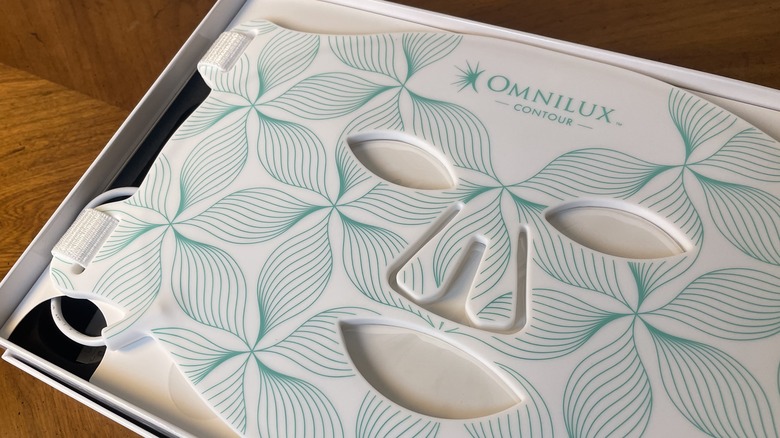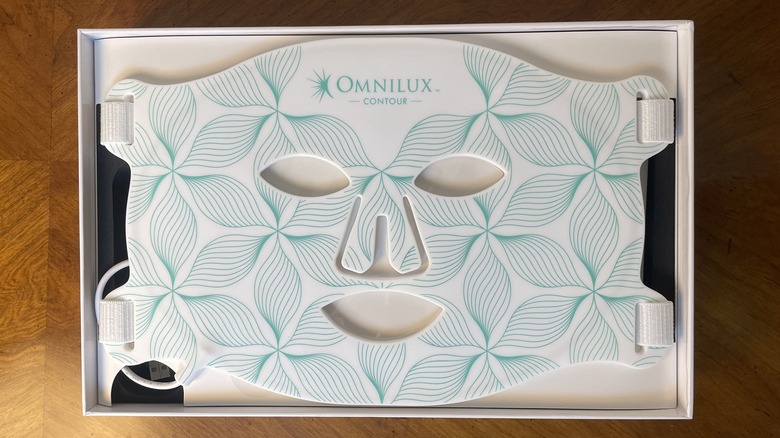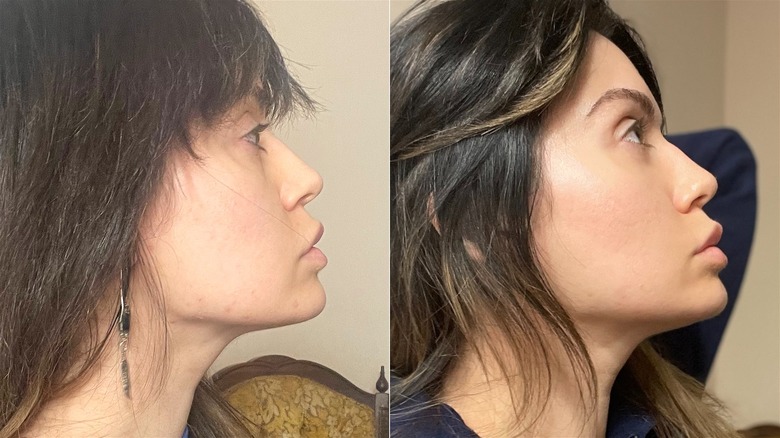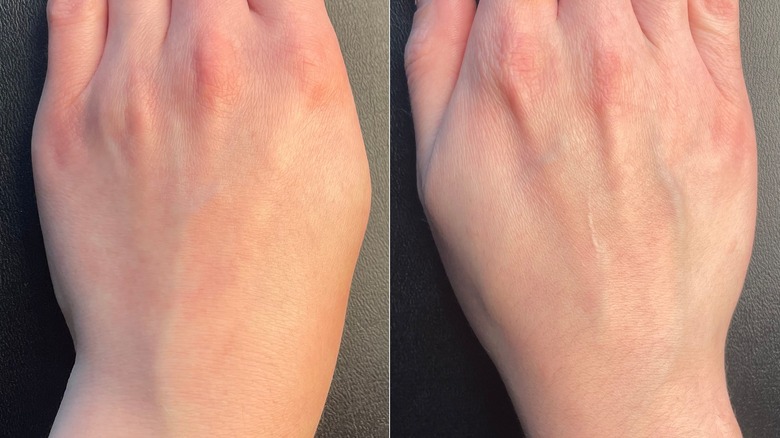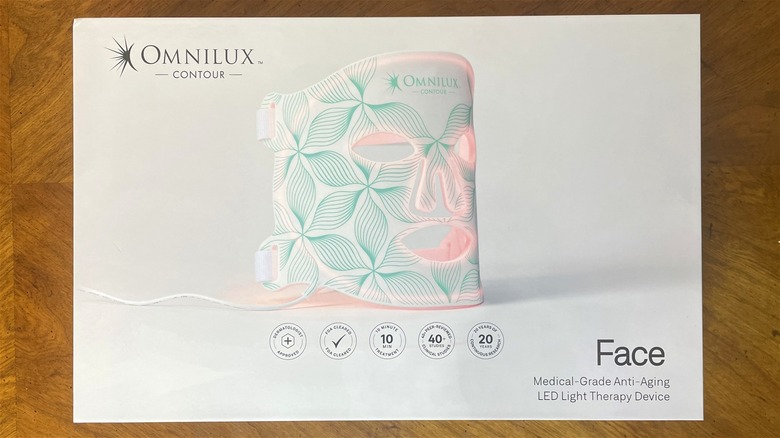We Tried Omnilux's Contour Face Mask & It Surpassed Expectations Despite Its Setbacks
We may receive a commission on purchases made from links.
If you consider yourself a skincare buff, you've probably heard of red light therapy. However, if this high-tech treatment has somehow skipped past your radar, let us introduce you to the concept. Red light therapy, sometimes called low-level laser light therapy, photobiomodulation, or LED therapy, involves safe concentrations of red light applied directly to the skin, and it's thought to stimulate cell turnover (via Healthline). It's earned quite a reputation within skincare circles for everything from brightening hyperpigmentation to treating fine lines and inflammation. Other types of light, including blue, are considered helpful for various skin conditions, particularly acne. Moreover, researchers have used low-level light therapy to treat dermatological ailments since the '60s, though at-home devices have only recently become widely available to consumers.
Over the past few years, we've seen scores of testimonials for this buzzy treatment across the internet. Still, we couldn't help but wonder if it worked. Most proponents of red light therapy utilize at-home masks or wands, ranging in price from about $30 to hundreds of dollars. Some, like Shani Darden by Déesse Pro, can even set one back a whopping $1,900. To determine whether red light therapy masks are truly worth the investment, we researched countless devices before settling on the much-discussed Omnilux Contour Face mask, which retails for $395. Over three weeks, we pared down our skincare routine and put the mask to the test. Despite some initial setbacks, it wasn't long before we learned that the hype surrounding light therapy was real.
How to avoid a glaring issue with red light therapy
Before we dive into our results, we must note that there are conflicting reports about the safety of LED light therapy devices and the eyes. The Omnilux Contour Face guide cautions that the device isn't for those with genetic eye conditions. Many skincare fans report using their light therapy masks without eye protection, watching television or scrolling through their phones throughout the process. However, several experts caution against this practice. "If you have underlying eye issues, make sure your eyes are covered," board-certified dermatologist Dr. Shereene Idriss told InStyle.
At first, we tried the Omnilux without eye protection but with our eyes closed — and we found it far too bright to endure for more than a few seconds, let alone a full 10-minute session. To continue our experiment, we found a workaround by using light-blocking goggles, the same type one might use for sun tanning or in-office skincare procedures like laser therapy. Using goggles can block out most of the mask's rays, though you can pair them with medical eye patches or adjust the mask lower down your face if you're concerned about blocking the light out completely. We also noticed that the light can be distracting when treating other areas, like the neck or hands. If this bothers you, try draping a towel over the back of the mask during your session.
With frequent use, we noticed improvements in our skin
It's important to note that red light therapy takes time to deliver transformational results. In some cases, according to manufacturers, it can take a month or more to receive the full benefits from red light. Still, we were impressed with the Omnilux's effects on our skin by the three-week mark. We refrained from using powerful active skincare ingredients for the duration of the experiment, sticking with a bare minimum skincare routine of cleanser, toner, moisturizer, and sunscreen. Our most pressing issues were acne, uneven skin tone, and hyperpigmentation, and we wanted to see how well red light could tackle them on its own. Though Omnilux manufactures products with blue light specifically to treat acne, we felt the Contour mask addressed this skin condition satisfactorily.
In our first photo, our skin was dull and dehydrated, with scattered hyperpigmentation along our jawline. We used the Omnilux mask for a full 10 minutes each session, at least five times per week. It took about one week to see improvements in clarity and texture, though others commented positively on our complexion by the second week. Whether coincidence or not, the Omnilux seemed responsible for a sudden influx of compliments. Despite traveling cross-country and wearing makeup daily, our skin appeared clearer and more hydrated than usual. Some minor blemishes developed during the treatment process, but overall, the mask had a positive effect on our skin in a short period.
Omnilux even worked its magic on our hands
The Omnilux Contour Face is a flat, bendable mask, and one of its selling points is that it can easily treat other areas, like the neck, hairline, or hands. Interestingly, the place that revealed the most significant improvement was our hands — or, rather, our hand. We used the Omnilux consistently on our left hand (pictured left) to see whether there might be a noticeable difference compared to our untreated right (pictured right). Almost immediately, it was easy to see how the Omnilux affected the skin of our left hand. After each session, the skin on the back of this hand looked plump and refreshed, as though we'd just applied moisturizer or had a paraffin wax bath treatment.
As our experiment continued, it became increasingly apparent that our left hand had undergone some visible changes compared to our right. The quality of our skin appeared brighter, more even, and softer. During winter, our hands tend to become severely dry and cracked. Our right hand showed signs of this trauma, particularly around the knuckle area, while our left hand felt and looked more hydrated. The only thing we changed in our routine was red light therapy, making us firm believers in its anti-inflammatory and skin-soothing benefits.
Final notes on using red light therapy
Overall, the Omnilux Contour delivered on many of its promises, from fighting inflammation to improving the tone and texture of our skin. As mentioned earlier, we noticed an uptick in positive comments from strangers and close friends while using the device, and we felt our skin health improved despite removing special steps and products from our regimen. Like any other skincare treatment in your routine, it's crucial to use red light therapy consistently. Most manufacturers suggest incorporating light therapy between three and five times each week, if not every day, for the best results. Furthermore, we cleaned our Omnilux Contour's surface with 70% isopropyl alcohol between each use to prevent breakouts from bacteria buildup.
It's worth noting that several products can offer similar results to the Omnilux Contour, depending on your needs. We'd also used targeted red and blue light devices like SkinGym's ZitLit LED Acne Fighting Stick with success in the past — a considerably more affordable option than the Omnilux, at about $35 per wand. Most importantly, make sure you choose a light therapy product from a trusted beauty retailer such as Sephora or Ulta or purchase your device directly from manufacturers like Omnilux or Dr. Dennis Gross. Some users have reported adverse effects with masks purchased from third-party sellers or brands, so be mindful of this if you choose to shop for a deal on red light therapy products elsewhere.
